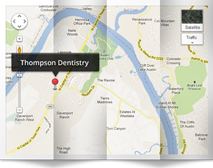The type of dental cleaning that is recommended is based on a diagnosis of either clinical health, gingivitis, or periodontal disease.
Prophylaxis
Prophylaxis is often referred to as a “regular cleaning”. It is used as a method to maintain healthy gums and to prevent and treat gingivitis, the reversible inflammation of the gums. During the prophylaxis, the doctor or hygienist removes the plaque, or sticky bacteria, and calculus, the hardened bacteria, from the teeth as well as any extrinsic stains. The teeth are polished and flossed, and the hygienist or doctor will go over individualized hygiene instructions to help you keep your teeth clean at home. Once the bacteria (plaque) hardens and becomes calculus, it can only be removed by special dental instruments and cannot be brushed off with your tooth brush, which is why professional dental cleanings are important. It is recommended that a patient with healthy gums, surrounding tissues, and bone, receive a regular dental cleaning (prophylaxis) every six (6) months in order to maintain their gum health. A person with gingivitis may need a more frequent cleaning depending on the severity of the gingivitis.
Scaling and Root Planning
Scaling and Root Planning is often referred to as a “deep cleaning”. It is used as a method to treat periodontal disease. Periodontal disease occurs when the hardened bacteria, or calculus, stays on the teeth too long and causes the gums to fall away from the teeth, and/or bone loss around the teeth. Periodontal disease is the leading cause of tooth loss. A person with periodontal disease may not know it is occurring until it is too late, which is why it is important to have a gum evaluation regularly to catch periodontal disease in its early state. If caught early, many times periodontal disease can be stabilized through scaling and root planning alone, however more advanced states of the disease may require further therapy by a periodontist, or gum specialist.
Scaling and root planning is similar to a prophylaxis in that all of the plaque and calculus are removed from the teeth by the doctor or hygienist, however, in the case of periodontal disease, the calculus, or hard bacteria deposits, are often further beneath the gums and on the root surface which requires instrumentation further underneath the gums and on the root surfaces as well. Because of this, it is often recommended that the patient be numb for scaling and root planning to make the procedure more comfortable for them. Dr. Thompson may also recommend laser therapy, see below, or localized antibiotics as an adjunct to scaling and root planning to aid in the healing process. After scaling and root planning, the patient should continue having 3 month cleanings, or periodontal maintenance visits, until the tissues are stabilized and the periodontal disease is no longer in the active state. This also requires good oral hygiene at home to keep the bacteria off of the teeth.
Laser Therapy
Based on the severity of the gingivitis, or diagnosis of periodontal disease, Dr. Thompson may recommend laser therapy during your hygiene visit to help restore your gums and tissues to health. Lasers can be used for many different procedures in dentistry and, during your cleaning, it can be used to reduce the bacteria counts under your gums and in the tissue itself, which cannot be removed with instruments alone. Laser therapy has been approved by the FDA and studies have shown that lasers can be a beneficial adjunct to your hygiene therapy.
Laser therapy can also be used during dental procedures to correct uneven gums or to remove infected tissue. When using the laser for these procedures, the tissues have a much faster healing rate than traditional surgical methods.
